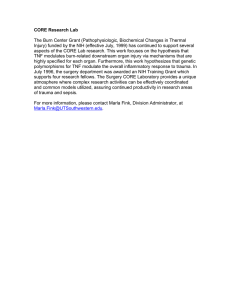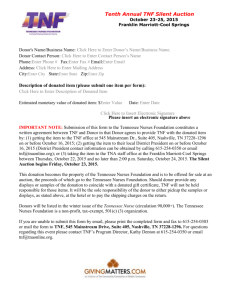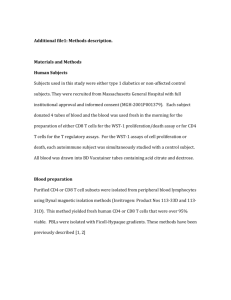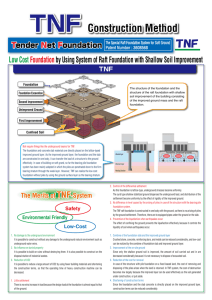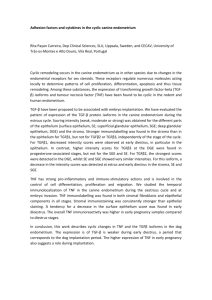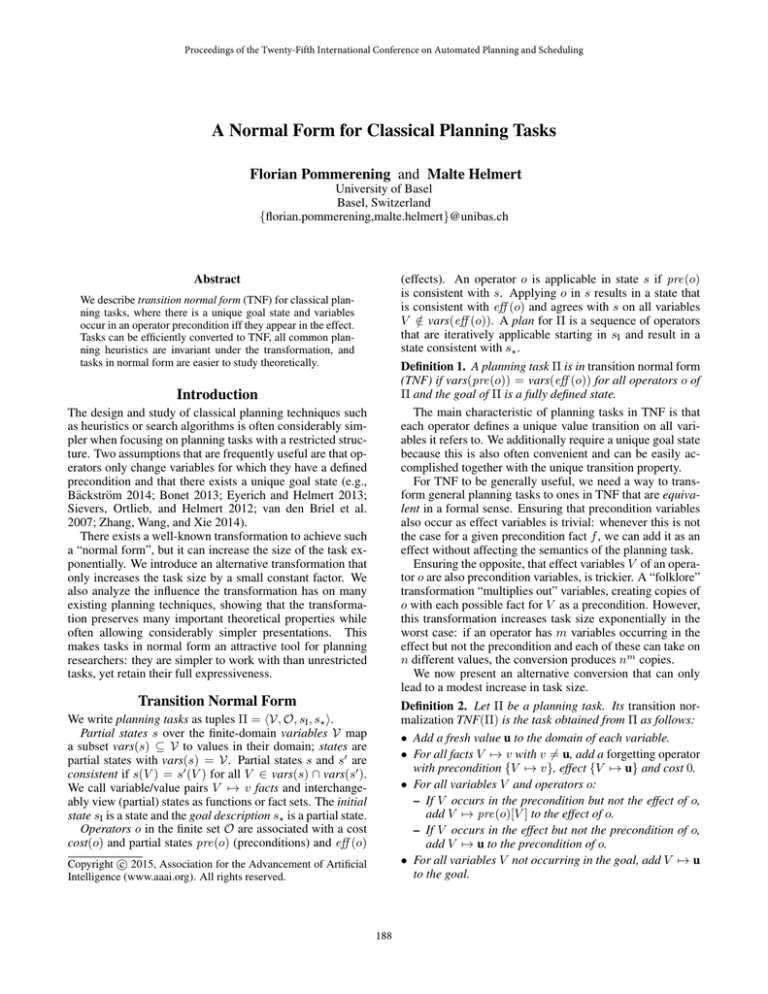
Proceedings of the Twenty-Fifth International Conference on Automated Planning and Scheduling
A Normal Form for Classical Planning Tasks
Florian Pommerening and Malte Helmert
University of Basel
Basel, Switzerland
{florian.pommerening,malte.helmert}@unibas.ch
(effects). An operator o is applicable in state s if pre(o)
is consistent with s. Applying o in s results in a state that
is consistent with eff (o) and agrees with s on all variables
V ∈
/ vars(eff (o)). A plan for Π is a sequence of operators
that are iteratively applicable starting in sI and result in a
state consistent with s? .
Definition 1. A planning task Π is in transition normal form
(TNF) if vars(pre(o)) = vars(eff (o)) for all operators o of
Π and the goal of Π is a fully defined state.
The main characteristic of planning tasks in TNF is that
each operator defines a unique value transition on all variables it refers to. We additionally require a unique goal state
because this is also often convenient and can be easily accomplished together with the unique transition property.
For TNF to be generally useful, we need a way to transform general planning tasks to ones in TNF that are equivalent in a formal sense. Ensuring that precondition variables
also occur as effect variables is trivial: whenever this is not
the case for a given precondition fact f , we can add it as an
effect without affecting the semantics of the planning task.
Ensuring the opposite, that effect variables V of an operator o are also precondition variables, is trickier. A “folklore”
transformation “multiplies out” variables, creating copies of
o with each possible fact for V as a precondition. However,
this transformation increases task size exponentially in the
worst case: if an operator has m variables occurring in the
effect but not the precondition and each of these can take on
n different values, the conversion produces nm copies.
We now present an alternative conversion that can only
lead to a modest increase in task size.
Definition 2. Let Π be a planning task. Its transition normalization TNF(Π) is the task obtained from Π as follows:
• Add a fresh value u to the domain of each variable.
• For all facts V 7→ v with v 6= u, add a forgetting operator
with precondition {V 7→ v}, effect {V 7→ u} and cost 0.
• For all variables V and operators o:
– If V occurs in the precondition but not the effect of o,
add V 7→ pre(o)[V ] to the effect of o.
– If V occurs in the effect but not the precondition of o,
add V 7→ u to the precondition of o.
• For all variables V not occurring in the goal, add V 7→ u
to the goal.
Abstract
We describe transition normal form (TNF) for classical planning tasks, where there is a unique goal state and variables
occur in an operator precondition iff they appear in the effect.
Tasks can be efficiently converted to TNF, all common planning heuristics are invariant under the transformation, and
tasks in normal form are easier to study theoretically.
Introduction
The design and study of classical planning techniques such
as heuristics or search algorithms is often considerably simpler when focusing on planning tasks with a restricted structure. Two assumptions that are frequently useful are that operators only change variables for which they have a defined
precondition and that there exists a unique goal state (e.g.,
Bäckström 2014; Bonet 2013; Eyerich and Helmert 2013;
Sievers, Ortlieb, and Helmert 2012; van den Briel et al.
2007; Zhang, Wang, and Xie 2014).
There exists a well-known transformation to achieve such
a “normal form”, but it can increase the size of the task exponentially. We introduce an alternative transformation that
only increases the task size by a small constant factor. We
also analyze the influence the transformation has on many
existing planning techniques, showing that the transformation preserves many important theoretical properties while
often allowing considerably simpler presentations. This
makes tasks in normal form an attractive tool for planning
researchers: they are simpler to work with than unrestricted
tasks, yet retain their full expressiveness.
Transition Normal Form
We write planning tasks as tuples Π = hV, O, sI , s? i.
Partial states s over the finite-domain variables V map
a subset vars(s) ⊆ V to values in their domain; states are
partial states with vars(s) = V. Partial states s and s0 are
consistent if s(V ) = s0 (V ) for all V ∈ vars(s) ∩ vars(s0 ).
We call variable/value pairs V 7→ v facts and interchangeably view (partial) states as functions or fact sets. The initial
state sI is a state and the goal description s? is a partial state.
Operators o in the finite set O are associated with a cost
cost(o) and partial states pre(o) (preconditions) and eff (o)
c 2015, Association for the Advancement of Artificial
Copyright Intelligence (www.aaai.org). All rights reserved.
188
Landmarks
The intuition behind the transformation is that we may
“forget” the value of a variable V (= set it to u) at any time
at no cost. This allows us to require a defined value for V
(namely, u) in TNF(Π) where Π mandates no defined value.
It is easy to see that TNF(Π) is in TNF and that its representation size in a reasonable encoding is at worst twice that
of Π. We now show that TNF(Π) and Π are equivalent.
A (disjunctive action) landmark is a set of operators from
which at least one has to be used in any plan. Several planning systems, such as LAMA (Richter and Westphal 2010),
and heuristics, such as LM-cut (Helmert and Domshlak
2009) and cost-partitioned landmarks (Karpas and Domshlak 2009), are based on this concept. Transition normalization preserves the landmarks of a planning task.
Theorem 1. Every plan π for Π can be converted into a plan
π 0 for TNF(Π) with the same cost in time O(k|π| + |s? |),
where k is the maximal number of effects of an operator,
and conversely in time O(|π 0 |).
Theorem 3. If L is a landmark of planning task Π, then L
is a landmark of TNF(Π). If L0 is a landmark of TNF(Π)
that does not include any forgetting operators, then L0 is a
landmark of Π.
Proof: To convert π into π 0 , insert the necessary forgetting
operators in front of each operator o: if o is executed in state
s, insert operators to forget V 7→ s[V ] for all variables V on
which o has an effect but no precondition. Also append such
operators to the end of the plan for each goal of the form
V 7→ u in TNF(Π). To convert a plan for TNF(Π) into a
plan for Π, simply drop all forgetting operators.
Proof: This is a direct consequence of the relationship between the plans of Π and TNF(Π) shown in Theorem 1. The LM-cut method is a landmark-based heuristic that
computes landmarks based on hmax values of planning
tasks. Together with the result for hmax shown in Theorem 2, it is not difficult to show that transition normalization
preserves LM-cut heuristic values.
As hinted in the introduction, TNF is useful because many
planning approaches can be described more simply while
losing none of their power when restricting attention to TNF.
In the remainder of this paper, we demonstrate this observation for a large number of example approaches. Many of
these examples relate to distance heuristics. A concise description of many of the heuristics we consider is given by
Helmert and Domshlak (2009).
Domain Transition Graphs and Abstractions
Many planning techniques make use of domain transition graphs (DTGs), which model the effect of operators
on individual variables of the planning task (Jonsson and
Bäckström 1998). The DTG of variable V is a digraph
with nodes dom(V ). It has an arc from v to v 0 labeled
by operator o if pre(o)[V ] = v and eff (o)[V ] = v 0 or if
V ∈
/ vars(pre(o)) and eff (o)[V ] = v 0 .
For tasks in TNF the latter case cannot occur, and hence
every operator o mentioning a variable V induces exactly
one arc in the DTG of V , from pre(o)[V ] to eff (o)[V ].
Hence, a definition of DTGs for tasks in TNF is simpler and
more directly communicates the underlying intent.
Conversion to TNF can also make domain transition
graphs considerably smaller: if variable V has n values and
there are n operators affecting it, each without a precondition on V , then the DTG of V in Π has n2 transitions, while
the DTG of V in TNF(Π) has only 2n transitions: n from
the original values of V to u and one for each operator. Intuitively, TNF(Π) represents the concept “operators with no
defined precondition value can be applied everywhere” only
once, rather than once for every such operator.
One application of DTGs where this can lead to practical performance benefits is within merge-and-shrink (M&S)
abstractions (e.g., Helmert et al. 2014). These are based on
the manipulation of explicitly represented abstract transition
systems, which are initialized to the atomic abstractions (=
DTGs) of the planning task. Avoiding a potential quadratic
increase in DTG size can be crucial for limiting the size of
M&S abstractions, as it is well-known that the number of
abstract transitions, not the number of abstract states, is the
main limiting factor of the approach.
A similar example is the DTG-based landmark test used
by LAMA (Richter and Westphal 2010). Using transitionnormalized tasks finds the same landmarks while improving
worst-case complexity for a landmark test from O(n2 ) to
O(n) due to the more favorable bound on DTG size.
Delete Relaxation and Critical Paths
Many planning heuristics can be understood as computing distances in a simplified version of the given planning
task Π. Important examples include the optimal deleterelaxation heuristic h+ (Hoffmann 2005), which ignores
delete effects, and the critical path heuristics hm (m ≥ 1),
which estimate the cost of reaching a state by recursively
estimating the cost of subgoals with up to m facts (Haslum
and Geffner 2000). A well-known special case of the latter is
the maximum heuristic hmax = h1 . Transition normalization
does not negatively affect these heuristics.
Theorem 2. Let Π be a planning task. For all states s of
Π, the values of h+ (s) and of hm (s) are the same in Π and
TNF(Π).
Proof sketch: Delete relaxation can be seen as a change in
semantics on planning tasks that does not affect the syntax.
A version of Theorem 1 for this modified semantics can be
proved analogously. This is sufficient to show that h+ (s)
is the same in Π and TNF(Π) since h+ is based on optimal
goal distances.
The hm heuristic assigns a value to each set of facts F
that intuitively measures the cost to reach a state containing
the facts in F considering only the cost of the hardest subset
whose size does not exceed m. The facts V 7→ u can always
be reached free of cost and do not allow reaching any other
state more cheaply than in the original task. The hm cost of
a partial state F in TNF(Π) is thus the hm cost of F without
all facts V 7→ u in Π.
189
Incremental Ranking and Zobrist Hashing
regression for a task in TNF is exactly the same as progression with the roles of sI and s? swapped and with pre(o) and
eff (o) swapped in each operator o. Hence with TNF, backward search is conceptually as simple as forward search.
In practical planning algorithms based on regression, this
observation is not necessarily all that useful: the fact that
general regression must reason about partial states is a boon
as much as a burden because it enables dominance pruning
techniques that are critical for strong performance. Therefore, conversion to TNF might incur a significant performance penalty despite the simpler theory.
However, the simple relationship between progression
and regression in TNF is very useful for reasoning about
regression, which is useful in a large number of planning
topics such as invariant synthesis (e.g., Rintanen 2008), relevance analysis (e.g., Haslum 2007) and reachability analysis (e.g., Hoffmann and Nebel 2001). There are also applications of regression where dominance pruning is not critical for performance, such as the seeding of perimeter PDBs
(Eyerich and Helmert 2013). Here, TNF can considerably
simplify efficient implementations.
Also within the area of abstraction heuristics, Sievers, Ortlieb, and Helmert (2012) show how a pattern database
(PDB) for a planning task can be efficiently computed using
a perfect hash function that assigns a unique rank to each
abstract state. The efficient implementation crucially relies
on avoiding unnecessary unranking and ranking operations.
Given a state s represented by its perfect hash value (rank)
and an operator o, we want to efficiently determine the rank
of the successor s0 of s reached via o. With operators in TNF,
this can be done by precomputing a constant offset for o and
then computing the rank of s0 as the rank of s plus the offset,
without the need for unranking and ranking operations to incorporate the effects of the operator. This advantage of TNF
is compelling enough that Sievers et al. use the exponential
transformation to compile operators into normal form.
A closely related application of TNF is within Zobrist
hashing. Botea et al. (2005) report that planners based
on state-space search can spend up to 35% of their runtime on calculating hash values for states in some domains. They use a Zobrist hash function (Zobrist 1970;
1990) to speed up the computation. For operators in TNF
(and not in the general case), the Zobrist hash of a state s0
reached from state s via operator o can be computed incrementally as hash(s) ⊕ c(o), where c(o) depends only on operator o and can be easily precomputed. (Here, ⊕ denotes
the binary XOR operation.)
State-Equation Heuristic
The state-equation heuristic (van den Briel et al. 2007;
Bonet 2013) observes that some operators produce a given
fact (change it from false to true) while others consume it
(change it from true to false). There must be a certain balance between how often a given fact is produced and consumed, and this balance can be encoded with numerical constraints (linear programs) from which heuristic values are
extracted by generic constraint optimization techniques.
What sounds like a clean and simple concept involves
substantial complications in practice. Without knowing the
state in which an operator o is applied, it is in general not
possible to tell if it produces (or consumes) a given fact. An
operator with precondition V 7→ v and effect V 7→ v 0 (with
v 6= v 0 ) will always consume V 7→ v and always produce
V 7→ v 0 . However, if an operator only has the effect on V
but not the precondition, it may produce V 7→ v 0 , but only
if s[V ] 6= v 0 in the state s in which the operator is applied.
Similarly, it may consume the current value of V , but we
cannot know what this value is from the operator description
alone. Similar vagaries arise from variables whose value is
unspecified in the goal.
As a consequence of these complications, the actual constraints used by the state-equation heuristic are not very obvious from the intuitive description of the idea:
X
Minimize
Yo cost(o) subject to
Regression
Most current search-based planning algorithms solve planning tasks by searching the state space in a forward direction (progression), starting from the initial state. However, a well-established and equally plausible approach is
to perform a backward search (regression) from the goal
towards the initial state (e.g., Bonet and Geffner 2001;
Alcázar et al. 2013).
In the general case, the search nodes of a regression search
are associated with partial states s0 , which correspond to all
states that agree with s0 on vars(s0 ). Regression is often seen
as more complicated than progression, and several recent
papers discuss the theoretical and practical complexities involved in regression for SAS+ -like planning tasks at length
(Alcázar et al. 2013; Eyerich and Helmert 2013). With unrestricted planning tasks, an operator o is regressable in a
partial state s0 iff
• for all V ∈ vars(eff (o)): V ∈
/ vars(s0 ) or eff (o)[V ] =
s0 [V ], and
• for all V ∈ vars(pre(o)) \ vars(eff (o)): V ∈
/ vars(s0 ) or
0
pre(o)[V ] = s [V ].
The regression of o in s0 is then defined as the partial state s
with vars(s) = (vars(s0 ) \ vars(eff (o))) ∪ vars(pre(o)) and
pre(o)[V ] if V ∈ vars(pre(o))
s[V ] = 0
s [V ]
otherwise
o∈O
Yo ≥ 0 for all o ∈ O
X
X
X
[f ∈ sI ] +
Yo +
Yo ≥ [f ∈ s? ] +
Yo
o∈APf
o∈SPf
o∈ACf
for all facts f
for all V ∈ vars(s).
Compared to progression, these definitions are rather involved. However, for tasks in TNF, regression can be defined in a way that is perfectly analogous to progression:
where APf , SPf and ACf are the sets (whose nontrivial definitions we omit for brevity) of operators that always produce, sometimes produce and always consume fact f .
190
where maxpot is a function mapping a variable V and a partial state p to the LP variable that represents the maximal
potential for a fact of V that is consistent with p:
PV 7→v if (V 7→ v) ∈ p
maxpot(V, p) =
MaxV otherwise
For tasks in TNF these complications disappear. Every
operator defines a well-defined value transition on the variables it mentions, so we can simply count the number of
consumers of f (operators with precondition f ) and producers of f (operators with effect f ) directly. We also have no
uncertainty regarding the goal state, and consequently we
can always use equations instead of inequalities:
X
Minimize
Yo cost(o) subject to
For tasks in TNF, the definition is much simpler:
Definition 4. (Pommerening et al. 2015) Consider a planning task Π = hV, O, sI , s? i in TNF. The TNF potential
function for facts of Π has to satisfy the TNF fact potential
constraints over the unrestricted LP variables Pf for every
fact f :
X
Pf ≤ 0
o∈O
Yo ≥ 0 for all o ∈ O
X
X
[f ∈ sI ] +
Yo = [f ∈ s? ] +
Yo
o∈O:f ∈eff (o)
for all facts f
o∈O:f ∈pre(o)
Similar to the heuristics considered previously, it turns out
that the state-equation heuristic value for task Π is identical
to the heuristic estimate in TNF(Π) for which we can use the
simpler and cleaner constraint system. (We omit the proof of
this statement because we do not believe it is necessary for
the main point we want to make: that working with planning
tasks in transition normal form can make life substantially
easier for the planning researcher and thus be a valuable aid
in the design and analysis of planning techniques.)
f ∈s?
X
Pf −
f ∈pre(o)
X
Pf ≤ cost(o) for all o ∈ O
f ∈eff (o)
Theorem 4. Let Π be a planning task. The general fact
potential constraints of Π are equivalent to the TNF fact potential constraints of TNF(Π).
Proof: Transition normalization introduces a new value u
for every variable V and a “forget operator” for every fact
V 7→ v. The new operator leads to the constraint PV 7→v −
PV 7→u ≤ cost(o) = 0, or equivalently PV 7→v ≤ PV 7→u .
Setting PV 7→u = MaxV shows the theorem.
Potential Heuristics
Pommerening et al. (2015) recently introduced potential
heuristics, which are parameterized by an assignment of numerical values to facts of the planning task. The value assigned to a fact is called its potential, and the heuristic value
of a state is the sum of potentials for all facts it contains. In a
preprocessing step, the potentials are determined by a linear
program (LP) that encodes the requirement that the resulting
heuristic is consistent and admissible. Every feasible solution of this LP yields an admissible potential heuristic, and
we can choose any objective function to bias the choice of
heuristic towards ones that are expected to be informative.
The paper by Pommerening et al. only defines the LP for
tasks in TNF and refers to a technical report (Pommerening
et al. 2014) for the details of the construction in the general
case because the transition-normalized case is much easier
to understand and conveys the intuition of the idea much
better. Here we show that the LP for a general task (adapted
from the technical report) is equivalent to the LP given in
the paper for the task in TNF. This means that the simpler
definition for tasks in TNF is sufficient and can be used for
general tasks by means of transition normalization.
Definition 3. (Pommerening et al. 2014) Consider a planning task Π = hV, O, sI , s? i. The potential function for facts
of Π has to satisfy the general fact potential constraints over
the unrestricted LP variables Pf for every fact f and MaxV
for every variable V :
PV 7→v ≤ MaxV for all facts V 7→ v
X
maxpot(V, s? ) ≤ 0
Conclusion
We introduced transition normal form, a normal form for
planning tasks that has been informally considered before
(usually as a simplifying assumption, rather than an actual
normal form to convert to) without having received any detailed attention. We showed that general planning tasks can
be converted to transition normal form easily with a very
mild increase in representation size, unlike the worst-case
exponential transformations described in the literature. The
normal form is unobtrusive in the sense that the process of
normalization does not appear to lose information for any of
the commonly considered techniques in heuristic planning.
The raison d’être of transition normal form is that it
greatly simplifies core concepts of a surprisingly large number of planning approaches, especially those related to domain transition graphs, regression, and any concepts that
emphasize the flow of values of finite-domain state variables (as in the recently suggested state equation and potential heuristics). Several techniques that look technically
involved in the general case look crisp and clear for planning
tasks in transition normal form.
Transition normal form will not revolutionize the world of
classical planning, but we believe it can make many planning
researchers’ lives considerably easier at least some of the
time, and it deserves to be widely known.
V ∈V
X
Acknowledgments
(maxpot(V, pre(o)) − PV 7→v ) ≤ cost(o)
This work was supported by the Swiss National Science
Foundation (SNSF) as part of the project “Automated Reformulation and Pruning in Factored State Spaces” (ARAP).
(V 7→v)∈eff (o)
for all o ∈ O
191
References
Karpas, E., and Domshlak, C. 2009. Cost-optimal planning with landmarks. In Proceedings of the 21st International Joint Conference on Artificial Intelligence (IJCAI
2009), 1728–1733.
Pommerening, F.; Helmert, M.; Röger, G.; and Seipp, J.
2014. From non-negative to general operator cost partitioning: Proof details. Technical Report CS-2014-005, University of Basel, Department of Mathematics and Computer
Science.
Pommerening, F.; Helmert, M.; Röger, G.; and Seipp, J.
2015. From non-negative to general operator cost partitioning. In Proceedings of the Twenty-Ninth AAAI Conference
on Artificial Intelligence (AAAI 2015), 3335–3341. AAAI
Press.
Richter, S., and Westphal, M. 2010. The LAMA planner:
Guiding cost-based anytime planning with landmarks. Journal of Artificial Intelligence Research 39:127–177.
Rintanen, J. 2008. Regression for classical and nondeterministic planning. In Proceedings of the 18th European
Conference on Artificial Intelligence (ECAI 2008), 568–572.
Sievers, S.; Ortlieb, M.; and Helmert, M. 2012. Efficient
implementation of pattern database heuristics for classical
planning. In Borrajo, D.; Felner, A.; Korf, R.; Likhachev,
M.; Linares López, C.; Ruml, W.; and Sturtevant, N., eds.,
Proceedings of the Fifth Annual Symposium on Combinatorial Search (SoCS 2012), 105–111. AAAI Press.
van den Briel, M.; Benton, J.; Kambhampati, S.; and Vossen,
T. 2007. An LP-based heuristic for optimal planning. In
Bessiere, C., ed., Proceedings of the Thirteenth International Conference on Principles and Practice of Constraint
Programming (CP 2007), volume 4741 of Lecture Notes in
Computer Science, 651–665. Springer-Verlag.
Zhang, L.; Wang, C.-J.; and Xie, J.-Y. 2014. Cost optimal planning with LP-based multi-valued landmark heuristic. In Proceedings of the Thirteenth International Conference on Autonomous Agents and Multi-Agent Systems (AAMAS 2014), 509–516. IFAAMAS.
Zobrist, A. L. 1970. A new hashing method with application for game playing. Technical Report 88, Computer Science Department, The University of Wisconsin, Madison,
WI, USA.
Zobrist, A. L. 1990. A new hashing method with application
for game playing. ICCA Journal 13(2):69–73.
Alcázar, V.; Borrajo, D.; Fernández, S.; and Fuentetaja, R.
2013. Revisiting regression in planning. In Rossi, F., ed.,
Proceedings of the 23rd International Joint Conference on
Artificial Intelligence (IJCAI 2013), 2254–2260.
Bäckström, C. 2014. Parameterising the complexity of planning by the number of paths in the domain-transition graphs.
In Schaub, T.; Friedrich, G.; and O’Sullivan, B., eds., Proceedings of the 21st European Conference on Artificial Intelligence (ECAI 2014), 33–38. IOS Press.
Bonet, B., and Geffner, H. 2001. Planning as heuristic
search. Artificial Intelligence 129(1):5–33.
Bonet, B. 2013. An admissible heuristic for SAS+ planning
obtained from the state equation. In Rossi, F., ed., Proceedings of the 23rd International Joint Conference on Artificial
Intelligence (IJCAI 2013), 2268–2274.
Botea, A.; Enzenberger, M.; Müller, M.; and Schaeffer, J.
2005. Macro-FF: Improving AI planning with automatically
learned macro-operators. Journal of Artificial Intelligence
Research 24:581–621.
Eyerich, P., and Helmert, M. 2013. Stronger abstraction
heuristics through perimeter search. In Borrajo, D.; Kambhampati, S.; Oddi, A.; and Fratini, S., eds., Proceedings
of the Twenty-Third International Conference on Automated
Planning and Scheduling (ICAPS 2013), 303–307. AAAI
Press.
Haslum, P., and Geffner, H. 2000. Admissible heuristics
for optimal planning. In Chien, S.; Kambhampati, S.; and
Knoblock, C. A., eds., Proceedings of the Fifth International
Conference on Artificial Intelligence Planning and Scheduling (AIPS 2000), 140–149. AAAI Press.
Haslum, P. 2007. Reducing accidental complexity in planning problems. In Veloso, M. M., ed., Proceedings of
the 20th International Joint Conference on Artificial Intelligence (IJCAI 2007), 1898–1903.
Helmert, M., and Domshlak, C. 2009. Landmarks, critical
paths and abstractions: What’s the difference anyway? In
Gerevini, A.; Howe, A.; Cesta, A.; and Refanidis, I., eds.,
Proceedings of the Nineteenth International Conference on
Automated Planning and Scheduling (ICAPS 2009), 162–
169. AAAI Press.
Helmert, M.; Haslum, P.; Hoffmann, J.; and Nissim, R.
2014. Merge-and-shrink abstraction: A method for generating lower bounds in factored state spaces. Journal of the
ACM 61(3):16:1–63.
Hoffmann, J., and Nebel, B. 2001. RIFO revisited: Detecting relaxed irrelevance. In Cesta, A., and Borrajo, D., eds.,
Proceedings of the Sixth European Conference on Planning
(ECP 2001), 127–135. AAAI Press.
Hoffmann, J. 2005. Where ‘ignoring delete lists’ works:
Local search topology in planning benchmarks. Journal of
Artificial Intelligence Research 24:685–758.
Jonsson, P., and Bäckström, C. 1998. State-variable planning under structural restrictions: Algorithms and complexity. Artificial Intelligence 100(1–2):125–176.
192

